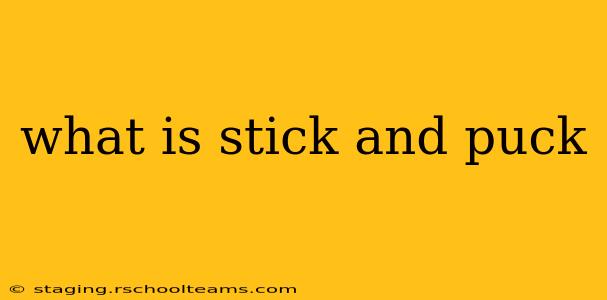Stick and puck is a popular form of informal ice hockey practice where players hone their skills in a relaxed, unstructured environment. It's a great way for players of all levels, from youth to adults, to improve their skating, shooting, passing, and puck-handling skills. But what exactly does it entail, and what are its benefits? Let's dive in.
What Happens During a Typical Stick and Puck Session?
Essentially, stick and puck involves players getting on the ice with their hockey equipment and practicing various skills independently or with a small group of friends or teammates. There's no structured coaching, no set drills, and no game situation. Instead, players focus on improving individual skills at their own pace. You might see players practicing:
- Shooting: Working on wrist shots, slap shots, backhand shots, and aiming at specific targets.
- Passing: Practicing short and long passes, developing accuracy and timing.
- Puck Handling: Improving stickhandling skills through drills, like weaving through cones or performing various stickhandling exercises.
- Skating: Working on skating technique, speed, and agility.
What are the Benefits of Stick and Puck?
Stick and puck offers numerous advantages for hockey players of all skill levels:
- Improved Skill Development: Consistent practice translates to significant improvements in puck handling, shooting accuracy, passing precision, and skating technique.
- Increased Confidence: Regular stick and puck sessions build confidence in one's abilities and create a sense of accomplishment as players master new skills.
- Enhanced Muscle Memory: Repetitive practice reinforces muscle memory, making the skills feel more natural and automatic during games.
- Fun and Relaxed Atmosphere: The informal setting provides a fun and relaxed way to improve hockey skills without the pressure of a formal practice or game.
- Cost-Effective Practice: Compared to organized team practices or private coaching, stick and puck is a more affordable option.
Where Can I Find Stick and Puck Sessions?
Many ice rinks offer designated stick and puck sessions at various times throughout the week. These sessions are often advertised on the rink's website or social media pages. You can also check with your local hockey association or league for information about available stick and puck opportunities.
How Often Should I Participate in Stick and Puck?
The frequency of stick and puck sessions depends on individual goals and availability. Some players attend multiple sessions per week, while others may only go once a month. Consistency is key; even a single session per week can yield significant improvements over time.
What Equipment Do I Need for Stick and Puck?
You'll need standard hockey equipment, including:
- Skates: Well-maintained skates are essential for comfortable and effective skating.
- Helmet: A properly fitted helmet is crucial for safety.
- Hockey Stick: Choose a stick that is the right length and flex for your size and playing style.
- Gloves: Hockey gloves provide protection and grip.
- Elbow Pads: Elbow pads offer protection from falls and impacts.
- Shin Guards: Shin guards are essential to protect your lower legs.
- Shoulder Pads: Shoulder pads protect your shoulders and chest from impacts.
- Hockey Pants: Hockey pants provide protection and comfort.
- Puck: A standard hockey puck is necessary for practicing shooting and passing.
Is Stick and Puck Suitable for All Skill Levels?
Absolutely! Stick and puck is beneficial for players of all levels, from beginners to seasoned professionals. Beginners can use the time to develop fundamental skills, while advanced players can focus on refining their technique and improving specific areas of their game.
Can I Do Stick and Puck Alone?
Yes, stick and puck can be enjoyed solo or with others. Practicing alone allows you to focus on your specific needs and weaknesses, while practicing with others provides opportunities for passing drills and friendly competition.
By consistently attending stick and puck sessions and dedicating time to practicing these skills, players can see marked improvements in their overall game performance. So, lace up your skates and get ready to experience the benefits of this accessible and effective hockey training method!
